| The Server Admin tool is where you start and stop, configure, and monitor most of the services Mac OS X Server has to offer. You can also change the serial number, computer name, and rendezvous name; run Software Update; set the date, time, and time zone; and enable a few advanced options (discussed later). Since Server Admin is part of the Server Administration Software package, it can be installed on any Mac OS X Client (running version 10.3). As a result, multiple servers can be administered from virtually anywhere, provided the server has a public IP address (Figure 2.49). Figure 2.49. The Server Admin tool lets you administer multiple servers from virtually anywhere. 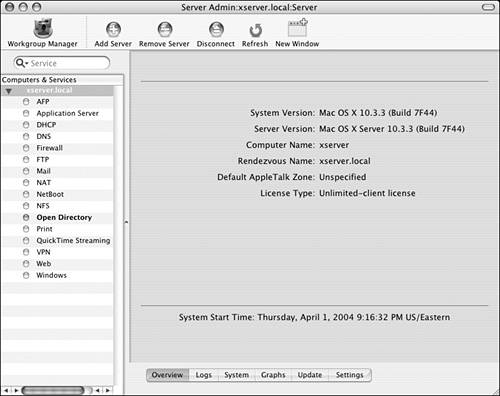
The first time you launch Server Admin, you'll need to connect to your server. A Connect dialog will drop down from the Server Admin window. Depending on where you're physically located, you have three options in the drop-down dialog: A direct connection to the server. If you're doing this on the server, the Address field contains the rendezvous name of the server and the logged-in administrator's name. A connection from another Mac OS X Server or Mac OS X Client running the Server Admin tool on your local network/subnet. You can click the Browse button  in the Server Admin Connect dialog and search for your server on your local network, or type in the known IP address or fully qualified domain name. in the Server Admin Connect dialog and search for your server on your local network, or type in the known IP address or fully qualified domain name. A remote connection from anywhere around the globe, provided your server has a public IP address. You'll need to have the IP address handy for entry into the Address field.
You'll enter your administrator name password, choose whether you wish to add the password to your keychain so you don't have to type it in later, and click the Connect button  (Figure 2.50). (Figure 2.50). Figure 2.50. Enter your administrator name and password, choose whether you wish to add the password to your keychain, and click Connect. 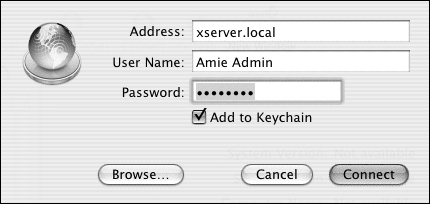
Once you're connected, you'll see your server in the left frame of Server Admin. Clicking the disclosure triangle expands or contracts your server, showing or hiding all the services available on that server (Table 2.2). Clicking any service shows you that service's settings and options in the right frame of the window. Table 2.2. Advanced Server Admin SettingsSETTING | MEANING | USAGE |
|---|
Enable SNMP | Simple Network Management Protocol | Allows remote queries of the server information via SNMP tools. These tools are often command-line or Web based and read data in a format that is likely to be unfamiliar to most users. | Enable NTP | Network Time Protocol | Allows a server to become a time server. Other computers can now enter the IP address or name of the server and receive their time synchronization from it. | Enable Macintosh Manager | Macintosh Manager | Starts the Macintosh Manager, which allows older Mac OS 8.19.2.2 clients to be managed. |
Address Name Differences In certain cases, you may see another name in the Address field. This may be due to the TCP/IP information you entered. If you entered a DNS address, you may have a domain name for your server assigned by another Domain Name Server. A fully qualified domain name is another name that is related to the IP address you have for your server. This name may be out of your control if you aren't the administrator of that Domain Name Server. The basics of DNS and Domain Name Server are covered in Chapter 6. |
Across the top is the Toolbar, which lets you add, remove, disconnect from, and refresh your server information (Figure 2.51). You can also create a new Server Admin window from the Toolbar, as well as launch the other main server management tool, Workgroup Manager. If you've selected a service, you may also see a Start Service button in the Toolbar  . If you wish to customize your Toolbar, you may do so by choosing View > Customize Toolbar. . If you wish to customize your Toolbar, you may do so by choosing View > Customize Toolbar. Figure 2.51. The Server Admin Toolbar lets you add, remove, disconnect from, and refresh your server information. 
 Tip Tip
You have two additional view options. You can view all your services and their respective status by choosing View > Show Summary, and you can quickly see your users and groups by choosing View > Show User Records. The former option displays the services and their status horizontally (Figure 2.52, below), and the latter opens a drawer on the left or right of the Server Admin tool that lets you see all the users and groups (Figure 2.53). Figure 2.52. Choosing View > Show Summary displays services and their status horizontally. 
Figure 2.53. Choosing View > Show User Records opens a drawer on the left or right of the Server Admin tool that lets you see all the users and groups. 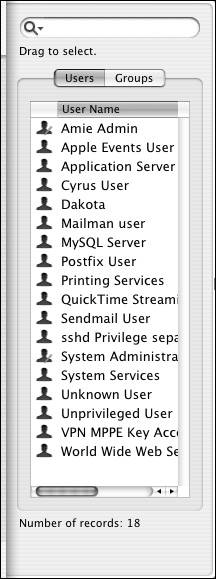
You'll probably access the Server Admin tool frequently; so, you may benefit from adding your server(s) to a Favorites list that gives you menu and keyboard shortcuts to the server(s). To do this, launch the Server Admin tool, choose Favorites > Add To Favorites, and select your server. You can now access your server when launching Server Admin by heading to the Favorites menu and choosing your server or using the Command key and the number associated with your server in the Favorites menu. If this is the first time you've done this, your server number will be 1 (Figures 2.54 and 2.55). Figure 2.54. Choose Favorites > Add To Favorites and select your server... 
Figure 2.55. ...to be able to access your server from the Server Admin Favorites menu. 
Setting Server Admin preferences You can customize Server Admin to further suit your needs. To do so, choose Preferences from the Server Admin menu. Some of the major options available to you are as follows (Figure 2.56): You can change the list display from Simple to Advanced, which will provide you with more information about how services are operating. You can enable secure connections and, if you do so, also provide a digital signature to ensure encryption. The digital signature option is discussed in Chapter 10. This option is especially important when you're administering a server from halfway around the world. The "Resolve DNS names when possible" option is used when servers have a properly configured DNS (discussed in Chapter 6).
Figure 2.56. You can customize Server Admin in the Server Admin Preferences dialog. 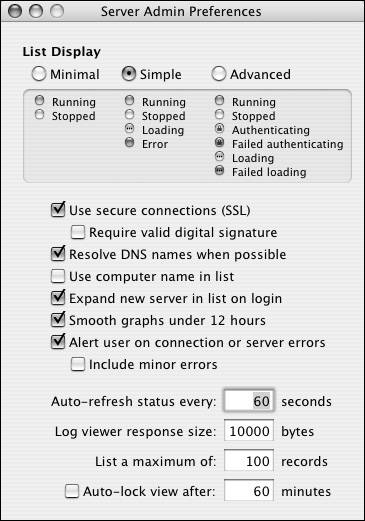
Server Admin and Unix Server Admin has a counterpart in the command line called serveradmin. You can run this tool from the server directly or, when you're connected to the server, from a remote machine via ssh. serveradmin has many options and can be used just like its GUI counterpart. Consult the man page for serveradmin to learn about all the features. |
To increase your Server Admin refresh rate: 1. | Launch the Server Admin tool, located in /Applications/Server (Figure 2.57).
Figure 2.57. The Server Admin tool's location on the disk. 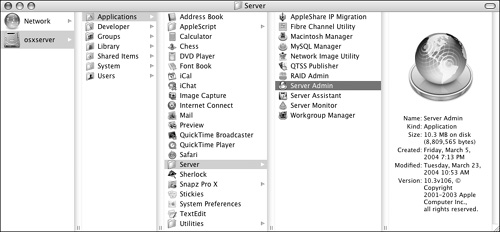
You don't need to authenticate, although you can.
| 2. | Choose Preferences from the Server Admin menu.
The Server Admin Preferences window opens.
| 3. | Change the option in the "Auto-refresh status" box to 30 seconds (Figure 2.58).
Figure 2.58. Change the Auto-refresh value in the Server Admin tool. 
| 4. | Close the Preferences window.
Your Server Admin tool will now update the status of all services much more quickly. It will also do this for all the servers in your Server Admin list.
|
 Tip Tip
|



 Tip
Tip



